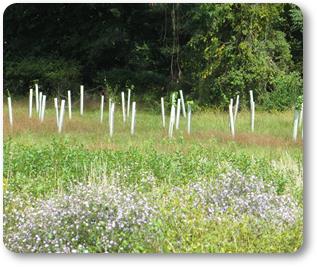Myth #1 – “Native Plants require less maintenance”
 As a grower of native plants it’s pretty clear we’re big fans of the value and benefits these plants play in our environment. They are tasked with greater expectations today to improve our water, purify our air, cool our homes, provide for our pollinators, calm our nerves and improve our health. There’s a lot more on their plate than simply being a new and pretty face in the garden.
As a grower of native plants it’s pretty clear we’re big fans of the value and benefits these plants play in our environment. They are tasked with greater expectations today to improve our water, purify our air, cool our homes, provide for our pollinators, calm our nerves and improve our health. There’s a lot more on their plate than simply being a new and pretty face in the garden.
Not Low Maintenance
That said, I’ve sat in several educational sessions where the speaker talks about benefits of native plants and refers to them as being lower maintenance than non-native species. An argument can be made that once established there is truthfulness to this point. There are however a myriad of non-native plants that have been cultivated for decades specifically to be “low maintenance” and they are quite honestly successful at it. But that is not the point of this discussion.
May Require More Maintenance
Our experience and those of the contractors and non-profits we work with shows that when it comes to environmental restoration, these projects and plants require MORE maintenance, not less. This is especially the case in the first 3-5 years of establishment. These plants face potentially daunting challenges including predation from wildlife, aggressive invasive plants, drought and flood, disease and alien insects and in some cases improper planting by poorly trained but well-meaning volunteers (trust me when I say we value all volunteers!).
We would argue that the success of a project is directly proportional to the time, energy and funds directed to addressing the issues above. Conversely, the risk of failure rises with the inability to reduce these risks. Often the government agencies and private sector projects provide funding for the initial planting and maybe the first year of maintenance. This simply isn’t enough resources to ensure a successful project over time. We have seen improvement over the past 25 years but funding for maintenance is still woefully inadequate.
Don’t Oversell
For our part as an industry of professionals, we must be careful not to oversell these plants without the full picture. It’s too easy to show the photo op moments in our presentations that show the challenging “before” and beautiful “after” images. What happens in between and the effort it takes to get a successfully established native plant community is the real issue and challenge. It is important that we convey this message.
My partner said to me early on in our business planning while discussing our mission for the nursery, “The goal is not to plant the plant, the goal is to have a forest in the end.” This is a simple statement that underscores the importance of increasing the focus on maintenance for these plant communities. It should be central to the pre-planning stages of any project, not an afterthought at the end of the day.
Challenges We Face
As I wrote this first blog I kept thinking of Donald Southerland in the movie Kelly’s Hero’s saying “always with the negative vibes.” I’m an eternal optimist and promise that future blogs will include uplifting topics too. But we can’t be afraid to look at the challenges we face in pursuing our goal; best expressed in the oft-quoted Greek Proverb “A society grows great when old men (and women) plant trees whose shade they know they shall never sit in.” I love this quote like many others, but it takes dedicated maintenance of native plant communities to achieve this goal for future generations.




So glad you are bringing this to light. More people talk about this aspect, and not try to fool lay people into planting natives, for the “low-maintenance aspect”.
So glad you are bringing this to light. More people should talk about this aspect, and not try to fool lay people into planting natives, for the “low-maintenance aspect”.